ISSN ONLINE(2319-8753)PRINT(2347-6710)
ISSN ONLINE(2319-8753)PRINT(2347-6710)
| S. K. Bhargava, S.S.Das and P. Paliwal Department of Electrical Engineering, MANIT, Bhopal, India |
| Related article at Pubmed, Scholar Google |
Visit for more related articles at International Journal of Innovative Research in Science, Engineering and Technology
In today’s scenario Distributed Generation (DG) resources have gained a lot of attention due to their positive impact on distribution system. Multisource hybrid power generationsystem with the utilization of Renewable Energy Resources (RES) are of greater concern considering environmental aspects. The considered resources are photovoltaic panels, wind turbine and battery storage. In this review various optimization techniques are compared in terms of multiobjective criteria comprising of reliability and cost analysis.
Keywords |
| RES, Hybridsolar-wind system, Multiobjective optimization, Optimization techniques. |
INTRODUCTION |
| With the rapid depletion of fossil fuel resources and increasing concern for air pollution and global warming, the renewable energy resources (RES) based Distributed Generation (DG) are expected to play a significant role in order to meet future demand [1,2]. The primary object of power system is to provide a reliable and economic supply to their consumers [3]. |
| There are various reasons for the rapid increasing in growth of Distributed Generation [3-7]: |
| 1. Increased public support and government incentives for the utilization of RES based DGs . |
| 2. DG units are closer to customer so that T&D investment are avoided or reduced. |
| 3. DGs offer a low capital cost and high reliability. |
| 4. Installation time of DG units is less and investment risk is not very high. |
| There are various renewable energy resources likes solar, wind, geothermal, bio-fuel, tidal etc.[1-16]. Among them wind and solar power are the two most widely used RES owing to their availability and ease in conversion [4,5,8,9]. Wind turbine generates no pollution and PV requires minimum maintenance to operate [4]. But the main drawback with these resources is that, the power fluctuation will occur. This is because since both these sources are highly dependent on weather, they may not match with the time dependent demand [10].This problem can be overcome by integrating both the resources in the proper combination with energy storage battery (SBs) [6,11,17]. The hybrid system is usually defined “A way of working, organizing or doing something that is composed of element of two separate systems”. A hybrid is the combination of two more different things, aimed to achieving particular objective or goal. The various advantages and disadvantages of hybrid system are summed up asfollows [5,6,8,9,24] and have been given in table I as follows: |
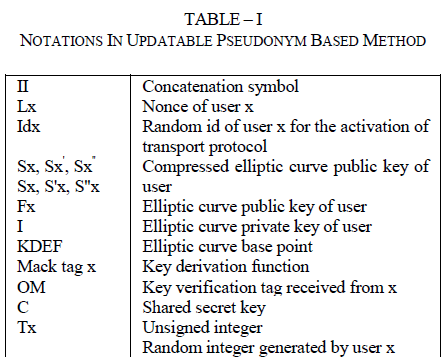 |
| One resource can overcome the weakness of other, so that the system reliability improves[8]. The objective of hybrid system planning is to achieve minimum cost at maximum reliability [20,23]. The design of the system aims at searching for the configuration that gives the lowest total cost throughout the useful life [25]. The following two objectives have been used in optimal planning of hybrid system: (i) Reliability (ii) Cost |
| Besides the fluctuation of time dependent sources, there are various uncertainties existing in operation of hybrid system such as component failure and stochastic nature of generation and load variation [13,19,26]. For reliability evaluation of hybrid power system adequacy evaluation theory [4], probabilistic indices [8,9,24,28], well being criteria [22,27] have been used in literature. Different cost evaluation criteria such as Annualized capital cost [4,8], Total life cycle cost [25], Levelised Cost of Energy [9,28] have been used by system planners for presenting a cost effective planning. In this review paper we study different optimization techniques to achieve an optimum combination for a hybrid system to meet the load demand, evaluation must be carried out on the basis of power reliability and life-cycle cost of the system. |
SOLAR- WIND BASED HYBRID POWER SYSTEM |
| Hybrid system of different energy resources like solar, wind, diesel, tidal, biogas, geothermal etc. are the most suitable energy sources togenerate electricity in some region of developing countries. A hybrid of solar-wind power generation system consists of a PV array, wind turbine, a battery bank and converters [5,6,8,9]. The hybrid of solar-wind system design is mainly dependent on the performance of individual component. In order to predict the system performance, individual components should be modeled first and then their combination can be evaluated to meet the demand reliability [8,32]. If the power output prediction from these individual component are accurate quite enough, the resultant combination will deliver power at the least cost. |
COMPONENTS OF HYBRID MODEL |
| A. PV ARRAY: |
| The performance of PV module is a function of the physical variables of the PV cell material, one being the temperature of solar irradiance exposed on the solar cells [7,16]. The power generated by photovoltaic (PV) system is directly proportional to the solar energy received by the PV panels. The number of panels needed is decided by the required load demand. |
| B.WIND TURBINE: |
| The power generated from wind turbine mainly depends upon the wind speed at a selected site where the wind turbine is installed and wind tower height [9]. Wind speed changes with height and the available wind data is measured at the different level of the tower. The wind power law is a useful tool for the measurement of wind data at different level [8]. |
| C.BATTERY BANK: |
| To enhance the system reliability, abattery bank is added in the hybrid model. The selection of proper size of battery bank for a particular application that requires the analysis of battery charging and discharging [11,15,33]. If the renewable sources produces power more than the demand, this surplus power is used to charge the batteries. If in case these renewable resources are unable to meet the load demand, than deficit power is provided by the batteries [4,17,18]. The system efficiency is largely dependent on battery ageing and thus batteries need to be replaced as and when required [8,17]. |
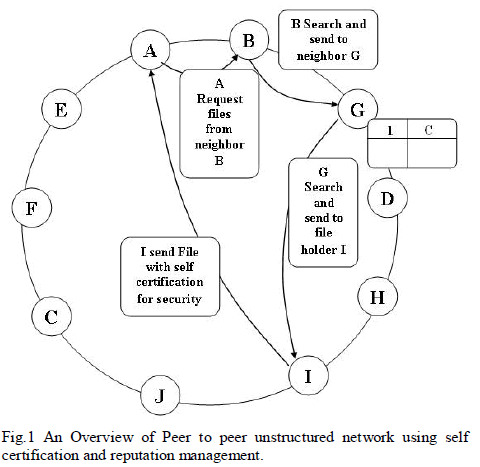 |
| Figure 1: Block Diagram of Hybrid Solar-Wind System [4] |
OBJECTIVE IN PLANNING |
| The objective of the power system is to supply electricity to its customers in an economical and reliable manner. In order to select an optimum combination for hybrid system to meet the load demand, evaluation must be carried out on the basis of power reliability, system life-cycle cost and environmental aspect. |
| A. Power Reliability analysis |
| With increasing interest of utilities worldwide in RES based technologies, it is essential to analyze the impact of RES based hybrid system along with storage on reliability benefits for efficient and effective system planning [20,23,26,33]. A reliable electrical power system means a system has sufficient power to feed the load demand during a certain period of time or a small loss of power supply [9]. Because of the intermittent solar radiation and wind speedcharacteristics, which highly influence the energy production fromthe hybrid system, power reliability analysis is usually consideredas an important step in any such system design process [19]. The reliability of power supply is increasing by the integration of DGs to distribution system [28]. |
| There are a number of methods used to calculate the reliability of the hybrid systems. The most popular method is the loss of power supply probability (LPSP) method [8]. The LPSP is the probability that an insufficient power supply results when the hybrid system (PV, wind power and energy storage) is not able to satisfy the load demand. The energy index of reliability (EIR) is used to measure the reliability of hybrid system design [4]. |
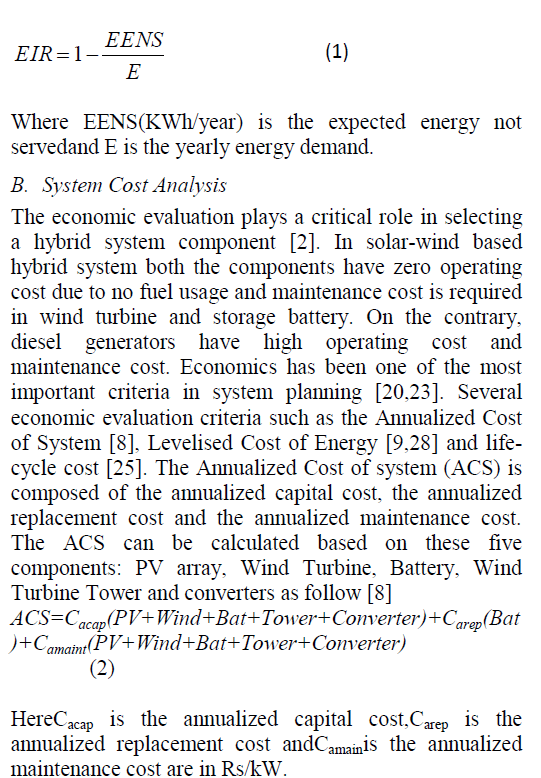 |
| The systemlifetime is usually considered to be the life of the PV modules,which are the elements that have a longer lifespan.The Levelised Cost of Energy is defined as the ratio of the totalannualized cost of the system to the annual electricity deliveredby the system and the discount rate. The discount rate generally in the range of 5-10%for generation of electricity [30]. |
| C. Environmental Aspect of Hybrid System |
| During the design of any system, the objective is that system is environment friendly which means that the total greenhouse gas emissions of the system during its lifetime is very less [2,21]. Environmental benefits encourage the uses of renewable based hybrid system such as wind turbine, solar photovoltaic panel and hydroelectric turbines since they consume no fossil fuels and reduces the greenhouse gas [3,4]. With the increase penetration of renewable, the system is utilized more effectively and efficiently through proper planning [26]. Katsigiannis et al.[2] the calculation of greenhouse gas emission on the bases of life cycle analysis (LCA) of each components. |
OPTIMIZATION TECHNIQUES |
| Various optimization methods are classified based on the type of the search space and objective function. The various optimization techniques are discussed in following subsections. |
| A. Analytical Techniques |
| Analytical technique is a mathematical model based optimization technique. The system is represented by a mathematical model and produces an algebraic expression that can be analyzed for optimization [3].Analytical technique require a short computing time. During a complex problem accuracy of the solution is override. Gozel et al. [34] have considered the effect of static load in determining the optimal size and site of DG unit as well on the minimization of losses. Wang and Nehir et al. [35] have presentedanalytical technique to determine the optimal location for placing DG in both radial and networked system for minimization of power losses subjected to voltage constrained. Acharya et al. [38] have presented a approach which is based on loss sensitivity factor that gives less computation and faster result. |
| B. Particle Swarm Optimization |
| PSO is a population based optimization technique and it is an evolutionary based computation techniques, where the system is initialized with a population of random particle, which is developed by Dr. kenedy and Dr. Eberhart in 1995[39,40]. PSO algorithm is initialized with a swarm of particle randomly placed on the search space. Each particle in a search space is initializing with velocity and position. The velocity of the particles updates by the particle previous best performances and by the previous best performances of the particle neighbors. |
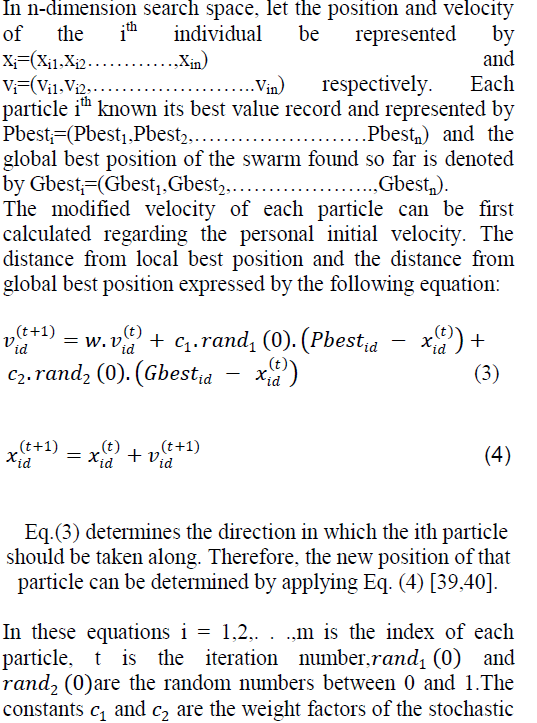 |
| acceleration terms, which pull each particle toward Pbest and Gbest positions. Low values allow particles to roam far from the target region before being togged back. On the other hand, high values result in abrupt movements toward, or backward the target region.Hence, the learning factors c1 and c2 are often set to 2.0 according to early experiences. We bear in mind that the PSO has been found to be robust and fast in solving nonlinear, non differentiable, multi-objective problems.Shi and Eberharthave introduced the parameter w into the PSO’s equation to improve its performance. The appropriate selection of inertia weight w, provides a balance between global and localexplorations, requiring less iteration on average to find a sufficiently optimal solution. |
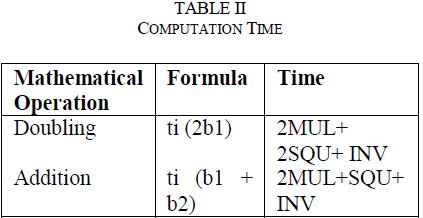 |
| the basis of their fitness value. After those crossover and mutation processes are done and generate a new population. The new population is used in the next iteration of algorithm. Afsari et al. [45] has proposed a multi-objective optimization model simultaneously minimizing the system cost while achieving the reliability. Teng et al. [50] have proposed a value based DG placement for overall improvement in service quality obtained through GA. GA has been found to be very effective in area of DG allocation but it is not very efficient in determining the absolute optimum. Therefore it is not the obvious choice when the high quality solutions are desired. To overcome this drawback, GA is hybridized with other techniques in order to improve efficiency. Gandomkar et al. [52] combined the simulated annealing in the production phase of GA to avoid the major drawback of simple genetic algorithm. The problem formulated with GA has no need of transform the non-linear problem into a linear modal. This approach is more beneficial for solving multiobjective problem. |
| D. Tabu Search |
| This meta-heuristics approach has dramatically changed the way we solve a host of optimization problem. It can be as an iterative technique that explores a set of problem solutions by repeatedly making moves from one solution to another [53]. Tabu search was created by Fred Glover in 1986, employing local search methods. It allows local search methods to overcome the local optima and escape from the occurrence of cycles, which usually cause even simple algorithms to terminate. In cases where many solutions are equally fit, these techniques have a tendency to become stuck. Tabu search is a very powerful optimization tool, and has the ability to avoid entrapment in local minima by using a flexible memory system. The memory system is a distinguishing feature of this metaheuristic technique, which equips it to solve the optimization problem even for a complex system. |
| Tabu Search is also employed by Nara et al [47], Golshan and Arefifar [48] to optimize DG size and location. In their proposed methodology they have extensively made use of the memory structures to effectively and economically direct the search to attractive regions in the solution space. |
| E. Ant Colony Optimization |
| ACO was first proposed by Marco Dorigo in 1992 in his PhD thesis; with an aim to find an optimal path in a graph. This optimization technique is based on the behavior of ants. It is a well-known fact that ants have the exceptional ability to find the shortest path from the nest to the food source; this fact is also used to find the optimal solution. This method uses a population to collectively solve the optimization problem under consideration. This technique gives better quality of results compared to other techniques. Though, it may take a considerable amount of time to give those results. |
| Lingfeng Wang et al. [50] have used ant colony system for radial distribution networks, to find the optimal location of DG placement. While keeping in mind that ACS can handle discrete optimization problem efficiently, the author has employed this technique to solve the problem in which a composite reliability index is used as the objective function. It was observed that the proposed ACS method gives solutions that are more accurate than the solutions obtained from GA method. It was also observed that the computational efficiency of ACO method was significantly higher than that of GA. However, it should be noted that, ACO may take a longer time to converge because a large number of potential solutions are to be evaluated. But the extra time needed is not as significant as that in analytical methods, since its computational efficiency is relatively insensitive to system complexity and size. |
CONCLUSION |
| In this review multi-objective optimization for sizing of solar-wind based hybrid power system is considered, with two main objectives viz. minimization of cost and maximization of the system reliability. There are several techniques, as studied above, which can provide an optimal solution to the problem. Since, PSO is easier to implement for a complex system and there are fewer parameter to adjust hence it can be used for a wide variety of hybrid power systems. It can significantly improve the obtained results, while not increasing the computing time significantly. Whenever a hybrid power system is to be installed on a large scale, system planers finds PSO as an extremely helpful optimization tool, as it very helpful in providing near-optimal solutions for complex systems. |
References |
|